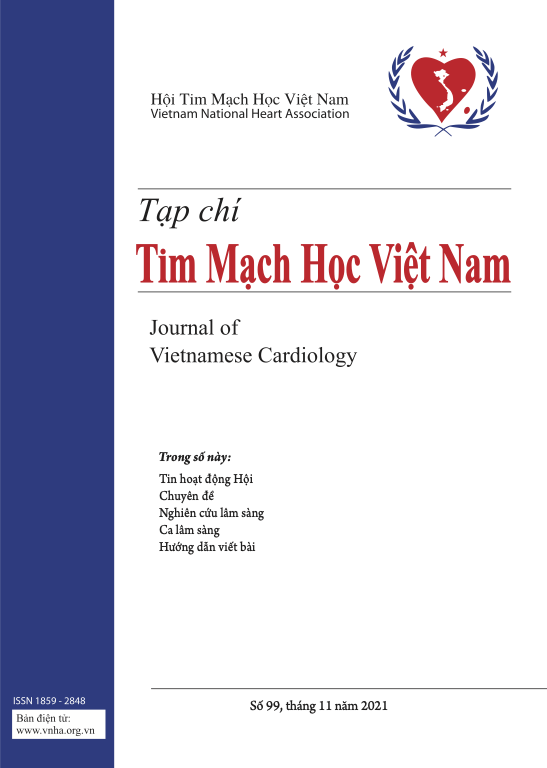Results of the Heart Failure Management Program at Hue Central Hospital after 1 year of implementation
DOI:
https://doi.org/10.58354/jvc.107E.2023.711Từ khóa:
heart failure, management, treatmentTóm tắt
Background: Heart failure is the consequence of many diseases that cause structural and/or functional disorders of the heart. Having a heart failure management program is essential to ensure patients receive optimal care and can improve clinical prognosis.
Objectives: 1. Describing realworld results of the Heart Failure Management Program at Hue Central Hospital; 2. Surveying the current status of prescribing drugs according to guidelines to treat heart failure in the program.
Studying methods: Implementation time is from July 2022 to September 2023 at Hue Central Hospital. The study design is a cross-sectional descriptive study with short-term longitudinal follow-up for at least 6 months.
Results: There were 734 patients including 445 men (60.6%) and 289 women (39.4%) with a mean age of 65.6 ± 15.4 years. The average follow-up time was 5.16 ± 3.53 months (the longest was 14 months). The prescription rates of ARNi, BB, MRA, SGLT2i were 55.9%, 77.9%, 78.7% và 76.5% respectively. After 6 months of management, these rates are 58.8%, 86.8%, 83.8%, 83.1% respectively. The average initial ejection fraction of the group of patients followed over 6 months was 34.5 ± 6.9%, after 6 months of management this rate increased to 39.9 ± 11.9%. The rate of rehospitalization due to heart failure decreased by 27.2% in the group of patients followed for more than 6 months. The mortality rate gradually decreased over time, from 4.4% to 1.7% after 6 months of follow-up.
Conclusion: The rate of optimal drug use in heart failure treatment improves over time, the death rate gradually decreases with each stage, but a lot of management measures need to be strengthened to avoid losing track of patients.
Tài liệu tham khảo
Ahn MS, Yoo BS, Son JW, et al. Evaluation of Adherence to Guideline for Heart Failure with Reduced Ejection Fraction in Heart Failure with Preserved Ejection Fraction and with or without Atrial Fibrillation. J Korean Med Sci. 2021 Oct 18;36(40):e252. doi: 10.3346/jkms.2021.36.e252.
![]()
Ashton CM, Wray NP. A conceptual framework for the study of early readmission as an indicator of quality of care. Soc Sci Med. 1996;43(11):1533-1541. doi:10.1016/s0277-9536(96)00049-4
![]()
El Hadidi S, Darweesh E, Byrne S, et al. A tool for assessment of heart failure prescribing quality: A systematic review and meta-analysis. Pharmacoepidemiol Drug Saf. 2018;27(7):685-694. doi:10.1002/pds.4430
![]()
Greene SJ, DeVore AD. The Maximally Tolerated Dose: The Key Context for Interpreting Subtarget Medication Dosing for Heart Failure. JACC Heart Fail. 2020;8(9):739-741. doi: 10.1016/j.jchf.2020.05.011.
![]()
Krumholz HM. Circulation: cardiovascular quality and outcomes: scholarship to improve health and health care for patients and populations. Circ Cardiovasc Qual Outcomes. 2008;1(1):1-3. doi: 10.1161/CIRCOUTCOMES.108.814509.
![]()
Martinez FA, Serenelli M, Nicolau JC, et al. Efficacy and Safety of Dapagliflozin in Heart Failure With Reduced Ejection Fraction According to Age: Insights From DAPAHF. Circulation. 2020;141(2):100-111. doi: 10.1161/CIRCULATIONAHA.119.044133.
![]()
McAlister FA, Stewart S, Ferrua S, et al. Multidisciplinary strategies for the management of heart failure patients at high risk for admission: a systematic review of randomized trials. J Am Coll Cardiol. 2004;44(4):810-9. doi: 10.1016/j.jacc.2004.05.055.
![]()
McMurray JJ, Packer M, Desai AS, et al. Angiotensinneprilysin inhibition versus enalapril in heart failure. N Engl J Med. 2014;371(11):993-1004. doi: 10.1056/NEJMoa1409077.
![]()
Mebazaa A, Davison B, Chioncel O, et al. Safety, tolerability and efficacy of up-titration of guideline-directed medical therapies for acute heart failure (STRONG-HF): a multinational, open-label, randomised, trial. Lancet. 2022;400(10367):1938-1952. doi: 10.1016/S0140-6736(22)02076-1.
![]()
Moleerergpoom W, Hengrussamee K, Piyayotai D, et al. Predictors of in-hospital mortality in acute decompensated heart failure (Thai ADHERE). J Med Assoc Thai. 2013;96(2):157-64.
![]()
Nieminen MS, Brutsaert D, Dickstein K, et al. EuroHeart Failure Survey II (EHFS II): a survey on hospitalized acute heart failure patients: description of population. Eur Heart J. 2006;27(22):2725-36. doi: 10.1093/eurheartj/ehl193.
![]()
Packer M, Anker SD, Butler J, et al. Cardiovascular and Renal Outcomes with Empagliflozin in Heart Failure. N Engl J Med. 2020;383(15):1413-1424. doi: 10.1056/NEJMoa2022190.
![]()
Pitt B, Pfeffer MA, Assmann SF, et al. Spironolactone for heart failure with preserved ejection fraction. N Engl J Med. 2014 Apr 10;370(15):1383-92. doi: 10.1056/NEJMoa1313731.
![]()
Vu QN, Do DT, Tran TH. Adherence to gdmt treatment for heart failure out-patients-single center registry. The Vietnam Journal of Cardiovascular and Thoracic Surgery. 2023;42:32-42. doi: 10.47972/vjcts.v42i.899.
![]()
Tromp J, Ouwerkerk W, van Veldhuisen DJ, et al. A Systematic Review and Network Meta-Analysis of Pharmacological Treatment of Heart Failure With Reduced Ejection Fraction. JACC Heart Fail. 2022;10(2):73-84. doi: 10.1016/j.jchf.2021.09.004.
![]()
Zannad F, Mebazaa A, Juillière Y, et al. Clinical profile, contemporary management and one-year mortality in patients with severe acute heart failure syndromes: The EFICA study. Eur J Heart Fail. 2006;8(7):697-705. doi: 10.1016/j.ejheart.2006.01.001.
![]()
Wier LM, Pfuntner A, Maeda J, et al. HCUP Facts and Figures: Statistics on Hospital-based Care in the United States, 2009. Rockville, MD: Agency for Healthcare Research and Quality, 2011
![]()








